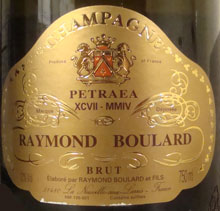Boulard Champagne
The family has been growing grapes since 1792
The Boulard Family has been growing grapes since 1792, for five generations and the Raymond Boulard label existed from 1980 to 2009. Raymond's children Francis, Hélène and Dominique have decided to go their own ways and now Francis Boulard makes wines under the Champagne Francis Boulard & Fille label and Dominique Boulard as Champagne Dominique Boulard & Filles. Francis does have a Web site and appears to be making an extremely similar line of wines (for example the Patraea reviewed below and Cuvée Les Rachais Extra Brut Blanc de blancs) while Dominique does not as of this writing and the third child. Not a lot of details are available yet, but feel free to contact them and report back with any new information (contact info here). We will discuss the father's wines as they are the ones on the market as of this writing and the family vineyards in this article.
Boulard is located between Reims and Epernay and has 10.25 hectares of vines as described below.
In the Marne Valley there are 5.45 hectares of vines, 4.45 in Marne on the right bank which are 75% Pinot Meunier, 20% Pinot Noir, and 5% Chardonnay, and 1 hectare in Aisne also on the right bank which is 75% Pinot Meunier and 25% Pinot Noir.
In Mailly-Champagne in the Montagne de Reims there are 1.65 hectares, all Grand Cru, of which 85% are Pinot Noir and 15% Chardonnay.
In Saint Thierry Massif in the Vesle Valley there are 3.0 hectares of vines, 60% Chardonnay, 20% Pinot Noir and 20% Pinot Meunier.
The goal is for all of them to be organic and enormous strides are being made in converting all the vineyards to organic cultivation and some to biodynamic (a very strict form of organic).
Low dosage, natural yeasts or selected dry yeasts when the natural ones do not work, and Malolactic fermentation or not depends on the style of the wine. Organic fertilizer, manual training of vines, and a slight manual thinning of the leaves in summer are employed.
Half stainless steel tanks and half oak barrels are used for fermentation. 5% of barrels are new and used Bordeaux barrels are used for Chardonnay and used Burgundy barrels are used for Pinot Noir.
Non vintage wines include a Cuvée Réserve, NV Blanc de Blancs, and a Rose. Their Petraea, also non vintage, (named after a species of oak used to make barrels) is made using the solera method. Their Les Rachais is a non vintage zero dosage Blanc de blancs. They also make a vintage wine and vintage rose.
 Tasting
Note: Raymond Boulard Petraea Brut
Tasting
Note: Raymond Boulard Petraea Brut
A light but bright yellow color with a lot of initial bubbles but quickly going to just a few in the glass
On the nose, sourdough bread, citrus, and chalk. Gentle apple with air. Slightly reductive.
The palate has lots of tangy citrus, it is very juicy and young tasting, with apples. A bit of melon.
Interesting, but this bottle at least was not exceptional at all. The nose and palate, although not out of synch, were very different. I didn't know it was made using a solera method until after I finished the bottle, but the slightly reductive notes on the nose fit in with this.
